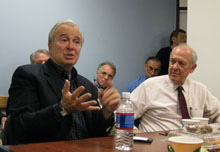
February 10, 2009 — At the Shorenstein Center’s brown-bag lunch, Ken Auletta, “Annals of Communications” columnist for the New Yorker, addressed the impact of the new media world on the old-media landscape.
Newspapers have been struggling to find the way forward, Auletta said. While they could significantly reduce their expenses by going online only — printing, paper and distribution account for 60 percent of many papers’ costs — he observed that they are not able to make up lost subscription revenue with online ad revenue. While online audiences are growing, individual users spend far less time on any one site: “The average reader of the New York Times spends 35 minutes a day reading the paper,” Auletta said. “And online readers of the New York Times? Thirty-five minutes a month.” That’s reflected in the rates advertisers are willing to pay.
The paradox is that some of the biggest online successes don’t make any money at all. “How much does Facebook make?” Auletta asked the room, and then held up his fingers to indicate the number zero. The same for YouTube, Twitter and other powerhouse sites. “Their audiences are growing, however,” he said — something that’s not the case for newspapers — and that makes their challenge very different.
A problem facing news organizations is that the dominant online culture believes information should be free. Generations have grown up with this belief, and while “it’s a wonderful culture, it’s not good for business,” he said, “and therefore it’s not good for journalism.” While online users value information, up until now they’ve shown themselves unwilling to pay for it. The exception is sites for the Wall Street Journal and the Financial Times, whose readers can often write off online subscription costs as a business expense, Auletta noted.
Perhaps an iTunes-like payment system for the news? Unlikely, Auletta said, explaining that “news is perishable.” Once users have read a story, they’re unlikely to read it again, and thus aren’t willing to pay for permanent ownership of content.
Despite the challenges of new media, Auletta felt that it provided considerable opportunities as well. Hurricane Katrina proved that citizen journalists had much to contribute, and that new online tools facilitate “two-way” journalism. “It got reporters off their mountain,” said Auletta, and required them to engage more with their audiences. He advised journalists to continue moving to a more interactive model without losing their ethical and reporting standards.
Reflecting on how journalists can reinvent themselves amid so much uncertainty, Auletta described two possible reactions: One is the “cemetery newsroom” that doesn’t take risks and fights to maintain a legacy business; the other is “leaning forward,” looking for new ideas and opportunities, remaining optimistic even if it means upsetting an existing business model.
What is ultimately needed, Auletta suggested, is an economic model in which the advanced tools of new media can be used to monetize the demand for news and bring significant revenue to news organizations. “We have the tools,” said Shorenstein Center director Alex S. Jones. If such a model could be developed, “it would be a golden era of journalism.”
This article was written by Janell Sims and the photos taken by Leighton Walter Kille, both of the Shorenstein Center.

